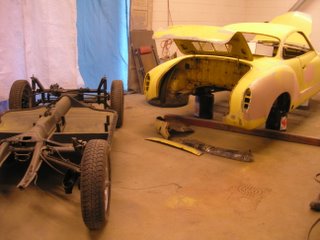Work that Body!
 Sorry to leave my throngs of adoring fans for so long (hi Mom). It's not for a lack of progress. The Karmann Eclectric is now in the capable hands of Tracy Payne, a local independent restorer. As you certainly recall from the mockup and 'before' shots, besides the rust repair, there were a few custom touches in store. Tracy has filled the front turn signals, in preparation for the early-style 'bullet' signals.
Sorry to leave my throngs of adoring fans for so long (hi Mom). It's not for a lack of progress. The Karmann Eclectric is now in the capable hands of Tracy Payne, a local independent restorer. As you certainly recall from the mockup and 'before' shots, besides the rust repair, there were a few custom touches in store. Tracy has filled the front turn signals, in preparation for the early-style 'bullet' signals.Anybody can slap on some fiberglass and filler, but check out the fine butt welding shown below!

Besides shaving the front signals, another custom touch that will be 'highly' visible is the elimination of the side trim strips. As shown below, Tracy has plugged the multitude of mounting holes with welds, instead of just spreading some filler, which would likely crack out with time..
Besides a progress report, the purpose of this shop visit was to reclaim the rolling chassis for additional upgrades, so we quickly lifted the body one more time, and I towed the naked pan home.

Once back in my garage, it was time to break up the rear suspension, which had certainly not been apart since the factory. The original VW suspension grommets were worn, but only somewhat loose, though the torsion bars did not want to come out. Fearful of finding rust, I was pleasantly surprised to see the hidden pieces looking like new. In this photo you can see the orange VW torsion bar, and the beefier black Porsche version (yes, its actually thicker, colors can deceive the eye).
 At our left, you can see the torsion tube retaining plate, the outer grommet, the outer torsion tube, the inner grommet, the original orange VW torsion bar, and the heavier Porsche 944 bar.
At our left, you can see the torsion tube retaining plate, the outer grommet, the outer torsion tube, the inner grommet, the original orange VW torsion bar, and the heavier Porsche 944 bar.These grommets are heavy-duty urethane instead of the original rubber.
In order to use the Porsche trailing arms, the VW outer torsion tube had to be swapped for it's Porsche cousin, but the VW retaining plate had to stay, since the 944 retainer is an elaborately cast aluminum fitting, complete with extra brackets for a body mount point, etc. that won't fit in the Ghia. Here are the two outer tubes side by side, 1986 Porsche and 1971 Volkswagen.

The torsion tubes are identical, but the welded-on spring plates differ, with the Porsche version having a wider bolt pattern for mounting the trailing arm. One additional detail that I wasn't alerted to by my research is that the Porsche rubber grommets are not simply pressed on, like VW, but actually molded in place on the steel tube. This meant that they were very difficult to remove, and after hours of slicing, sawing, chipping and chiseling, I resorted to man's second oldest companion- FIRE!

With enough emissions to offset my first few thousand miles of EV driving, the old grommets melted away in a sooty cloud, and a 3M stripping wheel proved to be just the ticket for removing the sticky residue that remained, along with all the paint and old undercoating on those tubes.

Before paint, it's time for a test fit!

So, on the right, we have the Porsche 944 Turbo suspension, and stock VW on the driver's side. It was important for me to do only one side at a time in order to keep track of changes and to more easily compare before and after measurements. Some items that were uncertain have been resolved. The wider wheels that rubbed against shock mounts when mocked up on the VW arms and brake drum actually line up perfectly when mounted on the Porsche arms and brake rotor, yet the Porsche arm's narrower track will keep the rubber inside my wheelwells. The shock mounts are aligned, and the bump stop on the arm swings right in line with the VW shock tower bump stop, but with one minor complication- both sides are now female! There's no provision to mount the rubber bumper. I'm apparently faced with drilling and tapping either the iron shock tower or the aluminum trailing arm in order to affix a bump stop. This will take a bit of study..

